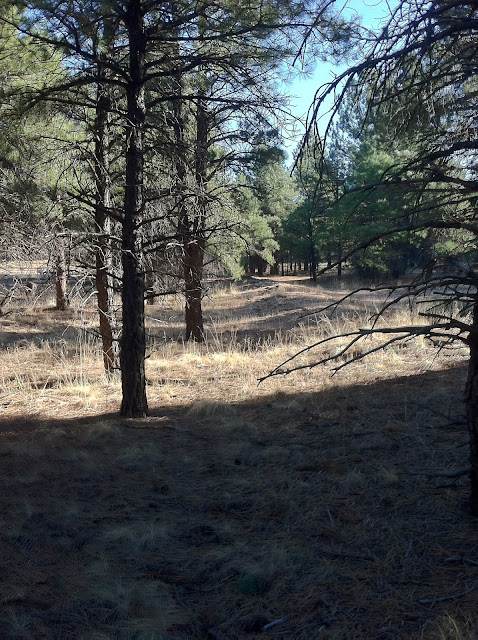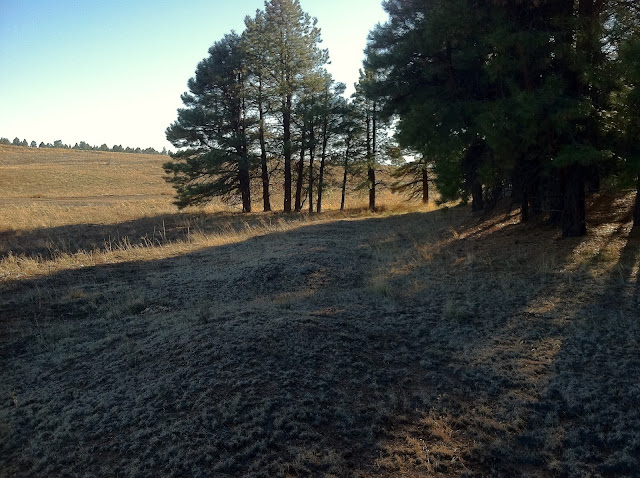The arrival of the Atlantic and Pacific Railroad in northern
Arizona in the early 1880s opened the door for the movement of goods into and
out of the region. While the region was
connected to the areas to the east and west, there was no rail connection to
the south. The Arizona Mineral Belt
Railroad (AMB) was proposed by Colonel James Eddy in 1881. The line originally was planned to begin in
Winslow but later Flagstaff was chosen as its start point. It was envisioned that the line would connect
with the copper mining town of Globe. At
this point, Globe was not connected to either the Atlantic and Pacific or the
Southern Pacific. Some even felt that
the line would eventually go as far south as Guaymas, Mexico and north to the
Utah Central RR which would create a continuous line from Mexico to the Pacific
Northwest (Trennert 1970).
Eddy was eventually able to get the Atlantic and Pacific to commit to
financing the initial construction of the line.
A large concern for Eddy was the question of how to deal with the
construction of the line down the Mogollon Rim.
It was decided that a tunnel would be bored through the Rim. Work on the tunnel began in 1883 prior to any
grading being done. The funds committed
by the Atlantic and Pacific ran out after 70’ of the planned 3100’ tunnel had been completed (Trennert 1970).
No further work was done until 1887 when the Atlantic and Pacific once
again committed more funding for the project.
Approximately thirty-five miles of line were completed to the Mormon
Mountain area. The funding was abruptly
cut-off once it was discovered that Eddy had sold $100,000 in AMB
stock to a Chicago businessman (Schuppert 1993). There were newspaper (Beatty 1956) references
as late as December 1887 stating that work would resume but it never came about.
The 1895 map below shows the AMB heading south from Flagstaff and ending at Fulton. Trennert (1970) states that a "railroad station for passenger and freight traffic" was established about ten miles south of Mormon Lake at the "crossing of the Winslow and Fort Verde Road". This would be roughly where Fulton is shown on the map. Schuppert (1993) as being just south of Mormon Mountain and being little more than a wooden cabin. Email correspondence from a local historian with longtime family ties to the area suggests one may not have existed.
The Arizona Mineral Belt Railroad - Current Day
There is a very short section of abandoned grade that can be seen directly across the street from the Circle K on Lake Mary Road. It is just behind the bus stop. New development has obscured or removed all evidence of the line for a short stretch but the grade can be found in the drainage between the apartment complex and the fire station on the west side of Lake Mary Road. It again is lost at the soccer field on South Wild West Trail in the Ponderosa Trails subdivision but it reappears shortly after and is adjacent to the paved walking/biking path leading west from the soccer field. It soon turns to the southwest. At this point it is a very noticeable large berm although it doesn’t stand out too well on this aerial image.
This next photo is this berm from the bike-path visible on the Google Earth image above.
Short portions of the line can be seen passing through yards
along West High Country Trail. It is visible in these next two photos.
The line continues from just west of the dead-end of West High Country Trail and goes down toward Pulliam Airport. The next photo show this section of the line.
It is a bit difficult to see but, on the above photo, the main AMB line is to the left and another line is forking off to the right. Here is another photo showing this right fork. This line quickly enters the off-limits airport property so it can't be followed much past this point. I've not seen this line shown on any maps so I'm not positive where it goes. I've heard some speculation that it heads down to the large east-west trending draw that is north of Mountainaire and ends near Lower Lake Mary and was used for the construction of the original dam.
The line from southwest of the airport to the north end of Lower Lake Mary is fairly easy to locate and follow. It heads southeast from the airport before it veers south and then back to the southeast. The road beginning near the upper left corner and continuing to the lower right corner is the line. It is now a dirt road but doesn’t receive much use as it pretty much dead-ends at the airport (when heading in a north-westerly direction). It makes the southerly turn near the well-defined dirt road in the lower right corner of the image.
The line continues from just west of the dead-end of West High Country Trail and goes down toward Pulliam Airport. The next photo show this section of the line.
It is a bit difficult to see but, on the above photo, the main AMB line is to the left and another line is forking off to the right. Here is another photo showing this right fork. This line quickly enters the off-limits airport property so it can't be followed much past this point. I've not seen this line shown on any maps so I'm not positive where it goes. I've heard some speculation that it heads down to the large east-west trending draw that is north of Mountainaire and ends near Lower Lake Mary and was used for the construction of the original dam.
The line from southwest of the airport to the north end of Lower Lake Mary is fairly easy to locate and follow. It heads southeast from the airport before it veers south and then back to the southeast. The road beginning near the upper left corner and continuing to the lower right corner is the line. It is now a dirt road but doesn’t receive much use as it pretty much dead-ends at the airport (when heading in a north-westerly direction). It makes the southerly turn near the well-defined dirt road in the lower right corner of the image.
Just prior to Forest Service Road 132 the line makes a
sweeping turn to the east-northeast. It
can be seen, in the center of the next image.
 |
| This portion of the grade is on private land. This is visible on the center right portion of the of the image below. The dashed red line shows the location of the grade. |
The line is adjacent to Forest Road 132 as it heads northeast and enters what is now Lower Lake Mary. During dry periods the grade can be followed down the middle of the lake bed. Water has somewhat leveled the line in places and these sections are usually most easily defined by subtle differences in vegetation. The line, along with two wyes, is visible on these subsets from a 2007 black and white U.S.G.S. digital ortho quarter quad. Depending on the vegetation conditions, the grade and the wyes can be easily seen or may be harder to make out. It really depends on the color, density and height of the vegetation, which of course is constantly changing. There is an old buried water line in this area which can be confused with the grade.
You'll soon come to a pipe, water box cover or some other waterline related object if you mistakenly follow a buried waterline instead of the grade.
The image below shows the grade heading south down the dry bed of Lower Lake Mary. The grass on the grade is denser than the grass cover directly adjacent. This is slightly elevated, but not by much. The action of water over the past nearly 120 years has caused the grade to spread out.
The darker vegetation is on the top of the grade.
Rail connector that has spent a lot of time submerged.
 |
| The lighter colored vegetation is on the grade. |
 |
| The grade approaching the Upper Lake Mary dam. |
The grade continues down Lower Lake Mary but becomes difficult to see near the dam on Upper Lake Mary. In 2008-9, the southern third or so of Upper Lake Mary was almost completely dry. The AMB grade really stood out. There are some substantial concrete abutments on a few of the places where the line crosses small drainages. Below is a 2007 aerial photo that shows a portion of the grade becoming visible as the water level in the lake went down. The AMB line continues to the southeast while the Flagstaff Lumber Company line can be seen, in the lower right corner, heading roughly south. This latter grade can be seen from Lake Mary Road. More information on this line can be found here: https://arizonarailsruinstrails.blogspot.com/2016/12/flagstaff-lumber-manufactoring.html
Much of the route of
the original AMB can be followed to the area between Upper Lake Mary and Mormon
Lake. There are several maps showing the line in the Mormon Lake area. One map shows it on the east side of Mormon Lake, another map shows it on the west side of
Mormon Lake just east of Mormon Mountain and ending down in Fulton Canyon, and
a third map showing it ending in the general location shown on the image below. This location, in UTM Zone 12, NAD 83 is
457195, 3873730.























I gotta tell ya, and I hope you see this, I've traced and placed points on all these old railroad grades on my Google Earth. I've traced the line beyond Fulton Tank to Allen Lake Landing--where you can see evidence of the roadbed and old ties as well. The line from SW Flagstaff, which ran through Mountainaire, also meets up at Allen Lake (where you can see the wye). It's quite interesting. I'm from Oklahoma but I have relatives who live here in the area and I love rail history.
ReplyDeletedo you have a kml file
DeleteA couple of points. First, there were two saw mills at MP16, near the upper Lake Mary dam. The first was called Mill No. 2, and was below the upper dam (to the north) not far from the road. There was a spur track into it. The first mention of it is in 1889, but it was probably there earlier. The last mention of Mill No. 2 was in 1894, when new ties were laid to MP16 and the mill. It probably burned shortly after that.
ReplyDeleteThe other mill was on the far side of the drainage from the current road, and is under water of the upper dam. It was built in about 1899, and called the Greenlaw Mill. It was removed in 1904 when the lower dam was built, and the rails were flooded by the lake.
The Mineral Belt did not go up the draw at the runway, but the one by the fire station. The Google-Earth pics above show that to be the case.
The Mineral Belt RR never went to Allan Landing, though it was projected to do that. The rails ended in Bear Park, about three miles short of Allan Lake. The obvious railbed in Allen Landing area is the much more recent bed, which was abandoned in the early 1960s.
The Mineral Belt used a very unusual spike, we call 'hollowbacks'; they have a groove down the backside, for an unknown purpose. Many were reused in the Central AZ Ry, but not in the FLM or later railroads. They are a dead giveaway that the grade was Mineral Belt or CARy; without them almost certainly not.
I have ridden along this for years using it to loop with the AZT and this is amazing to find out. The tunnel is not far from the AZT either.
ReplyDelete